An Improved BiLSTM Approach for User Stance Detection Based on External Commonsense Knowledge and Environment Information
Abstract
1. Introduction
- We define user stance based on the user-level social network dataset and divide user stance into three categories (i.e., support, neutral, and oppose).
- To detect user stance, we propose a stance detection method based on external commonsense knowledge and environmental information (ECKEI) to detect user stance in social networks, which provides useful insights into the importance of user stance in social networks. We use external commonsense knowledge to obtain emotional information to extend BiLSTM (CK-BiLSTM) to complement ordinary BiLSTM to obtain more information.
- We conduct extensive experiments to validate our model. Through experiments on two social network datasets, we present that our method outperforms several baseline methods in the user stance detection task. Our method achieves 68.65%, 70.07%, 78.48% in average micro-F1, average acuracy and average recall on the Brexit dataset and 72.86%, 73.44%, 83.27% on the election dataset, respectively.
2. Related Work
2.1. Stance Detection
2.1.1. Machine Learning Methods for Stance Detection
2.1.2. Deep Learning Methods for Stance Detection
2.2. Incorporating External Knowledge
3. Stance Definition and Task Definition
3.1. User Stance Definition
- SUPPORT: We can judge from the history tweet that the tweeter supports the target.
- NEUTRAL: We can judge from the history tweet that the tweeter is neutral or has no clue.
- OPPOSE: We can judge from the history tweet that the tweeter is against the target.
3.2. Task Definition
4. The Proposed Method
4.1. ECKEI Framework
4.2. Commonsense Knowledge
4.3. BiLSTM Network
4.4. CK-BiLSTM
4.5. Topic Extraction
4.6. Neighborhood Context
4.7. Attention-Based User History Tweets
5. Experimental Analysis
5.1. Dataset
5.2. Pre-Processing
5.3. Topic Setting
5.4. Baseline
- SVM-ngram [11]: This model is proposed in SemEval-2016 task6 and mainly uses multilingual features and characters to train the SVM classifier.
- NB [32]: This model is a naive Bayesian classification model. It also uses the monolingual features and the multilingual features of characters to train the naive Bayesian model.
- MTTRE(RNN) [20]: This model uses two recurrent neural network (RNN) classifiers to identify stance.
- Pkudblab(CNN) [21]: This model designs a predictive voting scheme using a convolutional neural network (CNN). The label with the highest frequency in all iterations is used as the final classification result.
- Temporal attention(TATT) [7]: This model is a deep attention CNN-LSTM method, which takes vectors in the timeline as context to capture the temporal dynamism in users’ stance evolution. It also uses useful relationship features available in additional social media such as friendship to improve performance.
- Affective-feature(Aff-Feature) [8]: The model uses and explores the features based on the sequence of events and extracts emotional features from emotional dictionaries such as EmoSenticNet (EmoSN) and Dictionary of Affect in Language (ANEW), and it uses an SVM classifier to achieve user stance classification.
5.5. Evaluation Metrics
5.6. Performance Comparison
5.7. Ablation Experiment
- ECKEI-BiLSTM: In order to analyze the effect of commonsense knowledge, we used ordinary BiLSTM instead of CK-BiLSTM in ECKEI.
- ECKEI-Topic: In order to evaluate the impact of topic information on stance classification, we removed the topic part for comparison.
- ECKEI-Attention: In order to evaluate the effect of the attention mechanism, we removed the attention mechanism part for comparison.
- ECKEI-Neighborhood: In order to evaluate the influence of neighbor information, we removed the neighbor information module for comparison.
5.8. Parameter Analysis
6. Conclusions and Future Work
Author Contributions
Funding
Institutional Review Board Statement
Informed Consent Statement
Data Availability Statement
Acknowledgments
Conflicts of Interest
References
- Gong, C.; Du, Y.; Li, X.; Chen, X.; Li, X.; Wang, Y.; Zhou, Q. Structural hole-based approach to control public opinion in a social network. Eng. Appl. Artif. Intell. 2020, 93, 103690. [Google Scholar] [CrossRef]
- Du, Y.; Zhou, Q.; Luo, J.; Li, X.; Hu, J. Detection of key figures in social networks by combining harmonic modularity with community structure-regulated network embedding. Inf. Sci. 2021, 570, 724–743. [Google Scholar] [CrossRef]
- Mohammad, S.; Kiritchenko, S.; Sobhani, P.; Zhu, X.; Cherry, C. SemEval-2016 Task 6: Detecting Stance in Tweets. In Proceedings of the 10th International Workshop on Semantic Evaluation, San Diego, CA, USA, 16–17 June 2016; The Association for Computer Linguistics: Stroudsburg, PA, USA, 2016; pp. 31–41. [Google Scholar] [CrossRef]
- Lai, M.; Cignarella, A.T.; Farías, D.I.H.; Bosco, C.; Patti, V.; Rosso, P. Multilingual stance detection in social media political debates. Comput. Speech Lang. 2020, 63, 101075. [Google Scholar] [CrossRef]
- Gorrell, G.; Aker, A.; Bontcheva, K.; Derczynski, L.; Kochkina, E.; Liakata, M.; Zubiaga, A. SemEval-2019 Task 7: RumourEval, Determining Rumour Veracity and Support for Rumours. In Proceedings of the 13th International Workshop on Semantic Evaluation, SemEval@NAACL-HLT 2019, Minneapolis, MN, USA, 6–7 June 2019; pp. 845–854. [Google Scholar] [CrossRef]
- Jannati, R.; Mahendra, R.; Wardhana, C.W.; Adriani, M. Stance Classification Towards Political Figures on Blog Writing. In Proceedings of the International Conference on Asian Language Processing, Bandung, Indonesia, 15–17 November 2018; pp. 96–101. [Google Scholar] [CrossRef]
- Veyseh, A.P.B.; Ebrahimi, J.; Dou, D.; Lowd, D. A Temporal Attentional Model for Rumor Stance Classification. In Proceedings of the 2017 ACM on Conference on Information and Knowledge Management, Singapore, 6–10 November 2017; pp. 2335–2338. [Google Scholar] [CrossRef]
- Pamungkas, E.W.; Basile, V.; Patti, V. Stance Classification for Rumour Analysis in Twitter: Exploiting Affective Information and Conversation Structure. arXiv 2019, arXiv:1901.01911. [Google Scholar]
- Wang, J.; Wang, Z.; Zhang, D.; Yan, J. Combining Knowledge with Deep Convolutional Neural Networks for Short Text Classification. In Proceedings of the Twenty-Sixth International Joint Conference on Artificial Intelligence, Melbourne, Australia, 19–25 August 2017; pp. 2915–2921. [Google Scholar] [CrossRef]
- Ofek, N.; Poria, S.; Rokach, L.; Cambria, E.; Hussain, A.; Shabtai, A. Unsupervised Commonsense Knowledge Enrichment for Domain-Specific Sentiment Analysis. Cogn. Comput. 2016, 8, 467–477. [Google Scholar] [CrossRef]
- Mohammad, S.M.; Sobhani, P.; Kiritchenko, S. Stance and Sentiment in Tweets. ACM Trans. Internet Techn. 2017, 17, 26:1–26:23. [Google Scholar] [CrossRef]
- Elfardy, H.; Diab, M.T. CU-GWU Perspective at SemEval-2016 Task 6: Ideological Stance Detection in Informal Text. In Proceedings of the 10th International Workshop on Semantic Evaluation, SemEval@NAACL-HLT 2016, San Diego, CA, USA, 16–17 June 2016; pp. 434–439. [Google Scholar] [CrossRef]
- Dey, K.; Shrivastava, R.; Kaushik, S. Twitter Stance Detection—A Subjectivity and Sentiment Polarity Inspired Two-Phase Approach. In Proceedings of the IEEE International Conference on Data Mining Workshops, ICDM Workshops 2017, New Orleans, LA, USA, 18–21 November 2017; pp. 365–372. [Google Scholar] [CrossRef]
- Wojatzki, M.; Zesch, T. ltl.uni-due at SemEval-2016 Task 6: Stance Detection in Social Media Using Stacked Classifiers. In Proceedings of the 10th International Workshop on Semantic Evaluation, San Diego, CA, USA, 16–17 June 2016; pp. 428–433. [Google Scholar] [CrossRef]
- Augenstein, I.; Vlachos, A.; Bontcheva, K. USFD at SemEval-2016 Task 6: Any-Target Stance Detection on Twitter with Autoencoders. In Proceedings of the 10th International Workshop on Semantic Evaluation, San Diego, CA, USA, 16–17 June 2016; pp. 389–393. [Google Scholar] [CrossRef]
- Dias, M.; Becker, K. INF-UFRGS-OPINION-MINING at SemEval-2016 Task 6: Automatic Generation of a Training Corpus for Unsupervised Identification of Stance in Tweets. In Proceedings of the 10th International Workshop on Semantic Evaluation, San Diego, CA, USA, 16–17 June 2016; pp. 378–383. [Google Scholar] [CrossRef]
- Trabelsi, A.; Zaïane, O.R. Unsupervised Model for Topic Viewpoint Discovery in Online Debates Leveraging Author Interactions. In Proceedings of the Twelfth International Conference on Web and Social Media, Stanford, CA, USA, 25–28 June 2018; pp. 425–433. [Google Scholar]
- Darwish, K.; Stefanov, P.; Aupetit, M.J.; Nakov, P. Unsupervised User Stance Detection on Twitter. In Proceedings of the Fourteenth International AAAI Conference on Web and Social Media, Held Virtually, Original Venue, Atlanta, GA, USA, 8–11 June 2020; pp. 141–152. [Google Scholar]
- Rashed, A.; Kutlu, M.; Darwish, K.; Elsayed, T.; Bayrak, C. Embeddings-Based Clustering for Target Specific Stances: The Case of a Polarized Turkey. In Proceedings of the Fifteenth International AAAI Conference on Web and Social Media, Held Virtually, Palo Alto, CA USA, 7–10 June 2021; pp. 537–548. [Google Scholar]
- Zarrella, G.; Marsh, A. MITRE at SemEval-2016 Task 6: Transfer Learning for Stance Detection. In Proceedings of the 10th International Workshop on Semantic Evaluation, San Diego, CA, USA, 16–17 June 2016; pp. 458–463. [Google Scholar] [CrossRef]
- Wei, W.; Zhang, X.; Liu, X.; Chen, W.; Wang, T. pkudblab at SemEval Task 6: A Specific Convolutional Neural Network System for Effective Stance Detection. In Proceedings of the 10th International Workshop on Semantic Evaluation, San Diego, CA, USA, 16–17 June 2016; The Association for Computer Linguistics: Stroudsburg, PA, USA, 2016; pp. 384–388. [Google Scholar] [CrossRef]
- Du, J.; Xu, R.; He, Y.; Gui, L. Stance Classification with Target-specific Neural Attention. In Proceedings of the Twenty-Sixth International Joint Conference on Artificial Intelligence, Melbourne, Australia, 19–25 August 2017; pp. 3988–3994. [Google Scholar] [CrossRef]
- Zhou, Y.; Cristea, A.I.; Shi, L. Connecting Targets to Tweets: Semantic Attention-Based Model for Target-Specific Stance Detection. In Proceedings of the Web Information Systems Engineering—WISE—18th International Conference, Puschino, Russia, 7–11 October 2017; Volume 10569, pp. 18–32. [Google Scholar] [CrossRef]
- Dey, K.; Shrivastava, R.; Kaushik, S. Topical Stance Detection for Twitter: A Two-Phase LSTM Model Using Attention. In Proceedings of the Advances in Information Retrieval—40th European Conference on IR Research, Grenoble, France, 26–29 March 2018; Volume 10772, pp. 529–536. [Google Scholar] [CrossRef]
- Sun, Q.; Wang, Z.; Li, S.; Zhu, Q.; Zhou, G. Stance detection via sentiment information and neural network model. Front. Comput. Sci. 2019, 13, 127–138. [Google Scholar] [CrossRef]
- Aldayel, A.; Magdy, W. Your Stance is Exposed! Analysing Possible Factors for Stance Detection on Social Media. Proc. ACM Hum. Comput. Interact. 2019, 3, 205:1–205:20. [Google Scholar] [CrossRef]
- Cignarella, A.T.; Lai, M.; Bosco, C.; Patti, V.; Rosso, P. SardiStance @ EVALITA2020: Overview of the Task on Stance Detection in Italian Tweets. In Proceedings of the Seventh Evaluation Campaign of Natural Language Processing and Speech Tools for Italian, Final Workshop (EVALITA 2020), Online Event, 17 December 2020. [Google Scholar]
- Siddiqua, U.A.; Chy, A.N.; Aono, M. Tweet Stance Detection Using an Attention based Neural Ensemble Model. In Proceedings of the 2019 Conference of the North American Chapter of the Association for Computational Linguistics: Human Language Technologies, Minneapolis, MN, USA, 2–7 June 2019; pp. 1868–1873. [Google Scholar] [CrossRef]
- Zhang, Y.; Qi, P.; Manning, C.D. Graph Convolution over Pruned Dependency Trees Improves Relation Extraction. In Proceedings of the Conference on Empirical Methods in Natural Language Processing, Brussels, Belgium, 31 October–4 November 2018; pp. 2205–2215. [Google Scholar] [CrossRef]
- Tian, H.; Gao, C.; Xiao, X.; Liu, H.; He, B.; Wu, H.; Wang, H.; Wu, F. SKEP: Sentiment Knowledge Enhanced Pre-training for Sentiment Analysis. In Proceedings of the 58th Annual Meeting of the Association for Computational Linguistics, 5–10 July 2020; pp. 4067–4076. [Google Scholar] [CrossRef]
- Xu, Z.; Liu, B.; Wang, B.; Sun, C.; Wang, X. Incorporating loose-structured knowledge into conversation modeling via recall-gate LSTM. In Proceedings of the International Joint Conference on Neural Networks, Anchorage, AK, USA, 14–19 May 2017; pp. 3506–3513. [Google Scholar] [CrossRef]
- Zhang, B.; Yang, M.; Li, X.; Ye, Y.; Xu, X.; Dai, K. Enhancing Cross-target Stance Detection with Transferable Semantic-Emotion Knowledge. In Proceedings of the 58th Annual Meeting of the Association for Computational Linguistics, Online, 5–10 July 2020; pp. 3188–3197. [Google Scholar] [CrossRef]
- Cambria, E.; Poria, S.; Bajpai, R.; Schuller, B.W. SenticNet 4: A Semantic Resource for Sentiment Analysis Based on Conceptual Primitives. In Proceedings of the 26th International Conference on Computational Linguistics, Osaka, Japan, 11–16 December 2016; pp. 2666–2677. [Google Scholar]
- Cambria, E.; Fu, J.; Bisio, F.; Poria, S. AffectiveSpace 2: Enabling Affective Intuition for Concept-Level Sentiment Analysis. In Proceedings of the Twenty-Ninth AAAI Conference on Artificial Intelligence, Austin, TX, USA, 25–30 January 2015; pp. 508–514. [Google Scholar]
- Hinton, G.E.; Osindero, S.; Teh, Y.W. A Fast Learning Algorithm for Deep Belief Nets. Neural Comput. 2006, 18, 1527–1554. [Google Scholar] [CrossRef] [PubMed]
- Hochreiter, S.; Schmidhuber, J. Long Short-Term Memory. Neural Comput. 1997, 9, 1735–1780. [Google Scholar] [CrossRef] [PubMed]
- Graves, A.; Schmidhuber, J. Framewise phoneme classification with bidirectional LSTM and other neural network architectures. Neural Netw. 2005, 18, 602–610. [Google Scholar] [CrossRef] [PubMed]
- Weerakody, P.B.; Wong, K.W.; Wang, G.; Ela, W. A review of irregular time series data handling with gated recurrent neural networks. Neurocomputing 2021, 441, 161–178. [Google Scholar] [CrossRef]
- Ma, Y.; Peng, H.; Cambria, E. Targeted Aspect-Based Sentiment Analysis via Embedding Commonsense Knowledge into an Attentive LSTM. In Proceedings of the Thirty-Second AAAI Conference on Artificial Intelligence(AAAI-18), New Orleans, LA, USA, 2–7 February 2018; pp. 5876–5883. [Google Scholar]
- Burns, N.; Bi, Y.; Wang, H.; Anderson, T.J. Enhanced Twofold-LDA Model for Aspect Discovery and Sentiment Classification. Int. J. Knowl. Based Organ. 2019, 9, 1–20. [Google Scholar] [CrossRef]
- Blei, D.M.; Ng, A.Y.; Jordan, M.I. Latent Dirichlet Allocation. J. Mach. Learn. Res. 2003, 3, 993–1022. [Google Scholar]
- Myers, S.A.; Zhu, C.; Leskovec, J. Information diffusion and external influence in networks. In Proceedings of the 18th ACM SIGKDD International Conference on Knowledge Discovery and Data Mining, Beijing, China, 12–16 August 2012; pp. 33–41. [Google Scholar] [CrossRef]
- Yang, Y.; Zhou, D.; He, Y. An Interpretable Neural Network with Topical Information for Relevant Emotion Ranking. In Proceedings of the 2018 Conference on Empirical Methods in Natural Language Processing, Brussels, Belgium, 31 October–4 November 2018; pp. 3423–3432. [Google Scholar] [CrossRef]
- Ren, Y.; Zhang, Y.; Zhang, M.; Ji, D. Context-Sensitive Twitter Sentiment Classification Using Neural Network. In Proceedings of the Thirtieth AAAI Conference on Artificial Intelligence, Phoenix, AZ, USA, 12–17 February 2016; pp. 215–221. [Google Scholar]
- Miura, Y.; Taniguchi, M.; Taniguchi, T.; Ohkuma, T. Unifying Text, Metadata, and User Network Representations with a Neural Network for Geolocation Prediction. In Proceedings of the 55th Annual Meeting of the Association for Computational Linguistics, Vancouver, BC, Canada, 30 July–4 August 2017; pp. 1260–1272. [Google Scholar] [CrossRef]
- Zhu, L.; He, Y.; Zhou, D. Neural opinion dynamics model for the prediction of user-level stance dynamics. Inf. Process. Manag. 2020, 57, 102031. [Google Scholar] [CrossRef]
- Xue, N. Steven Bird, Evan Klein and Edward Loper. Natural Language Processing with Python. Nat. Lang. Eng. 2011, 17, 419–424. [Google Scholar] [CrossRef]


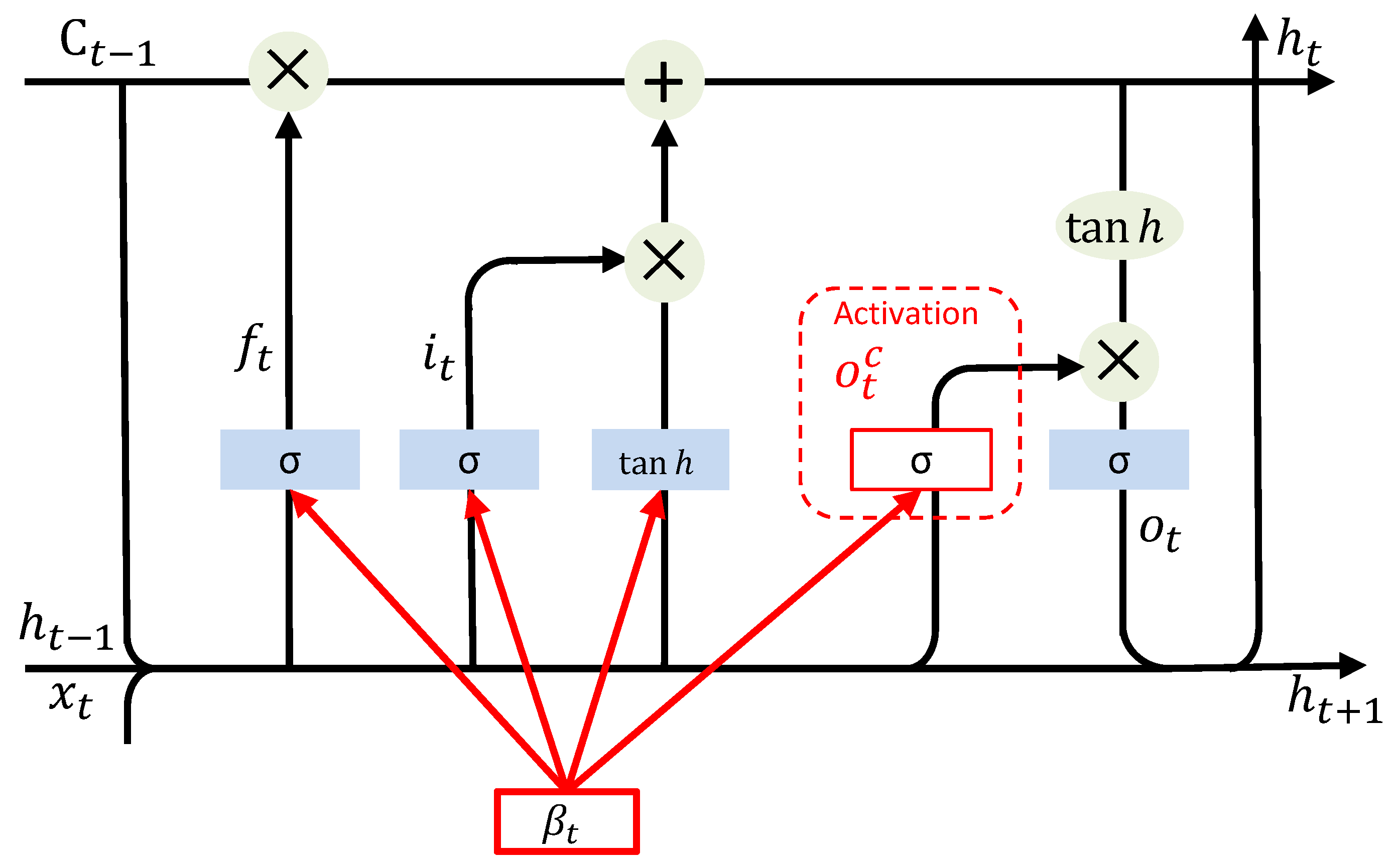
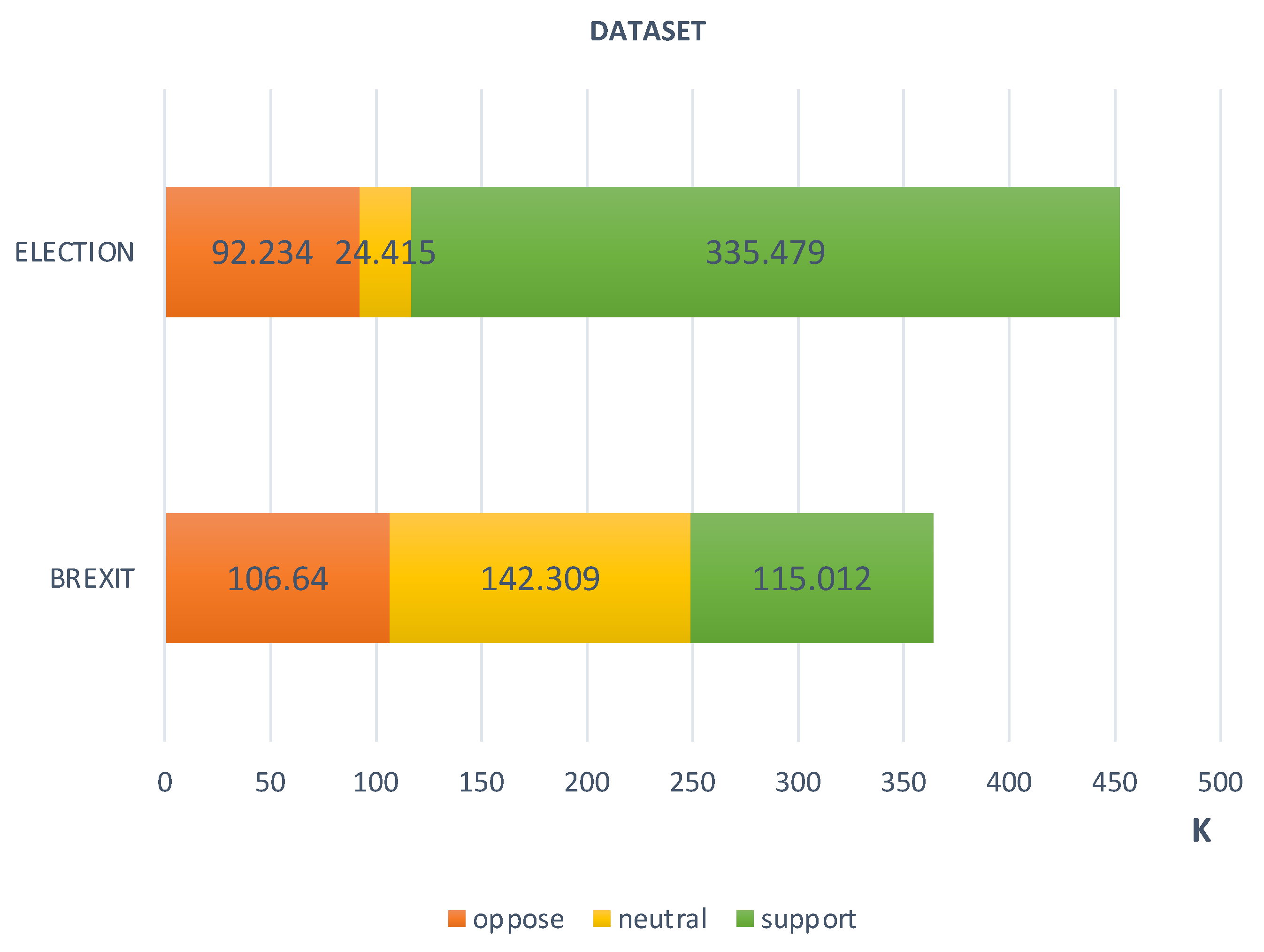


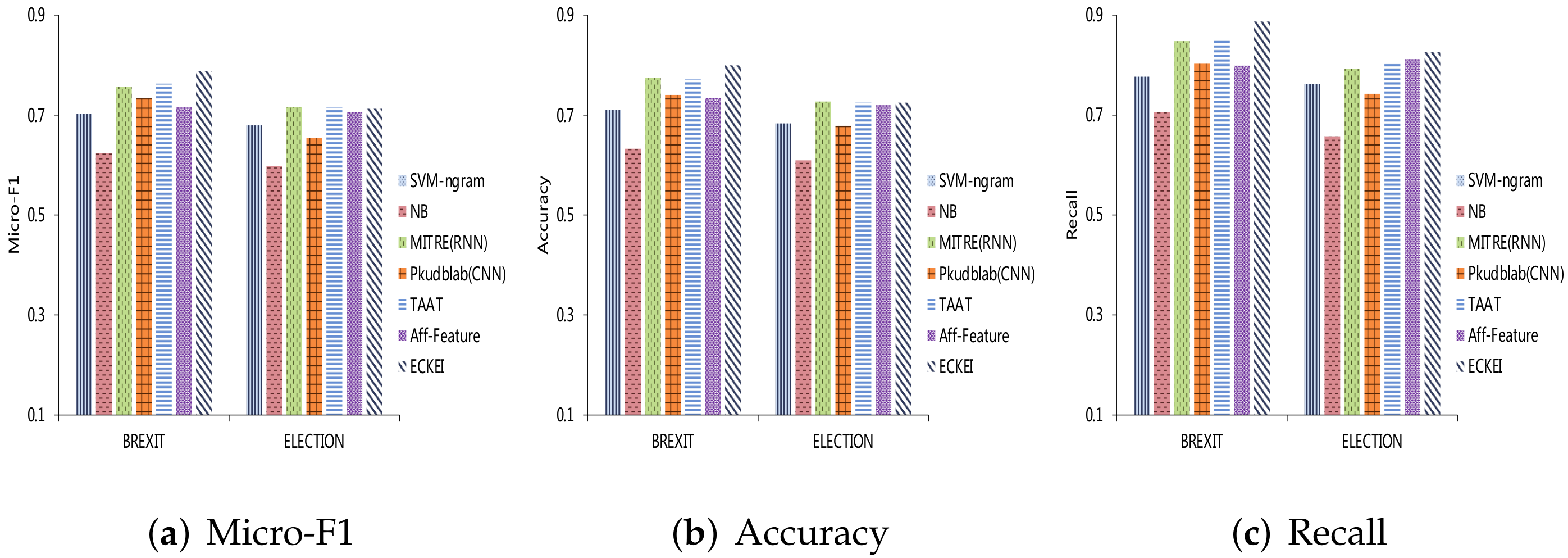
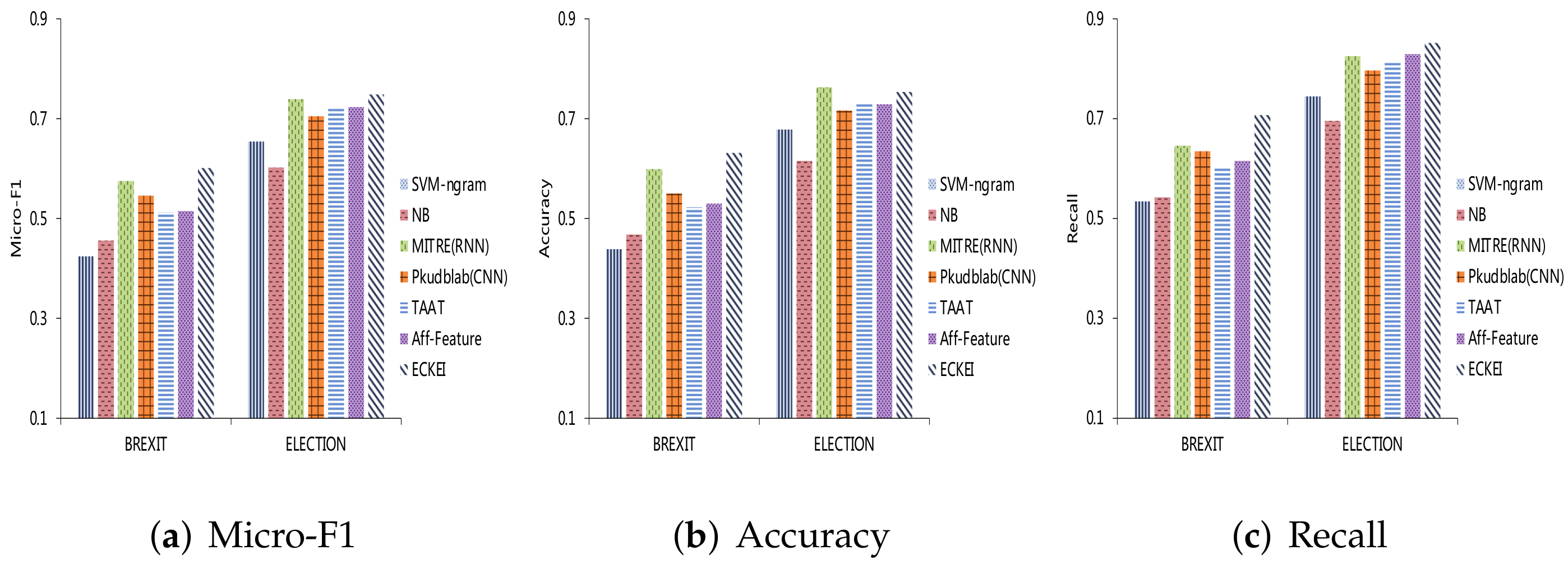
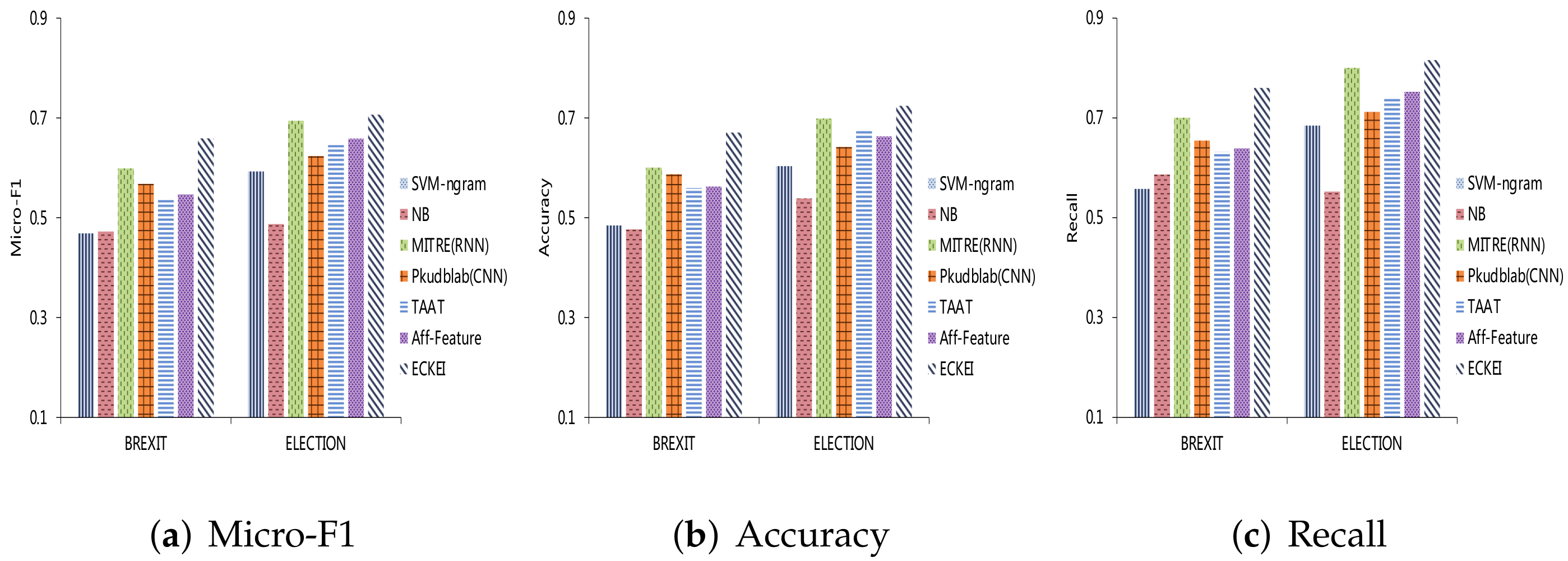
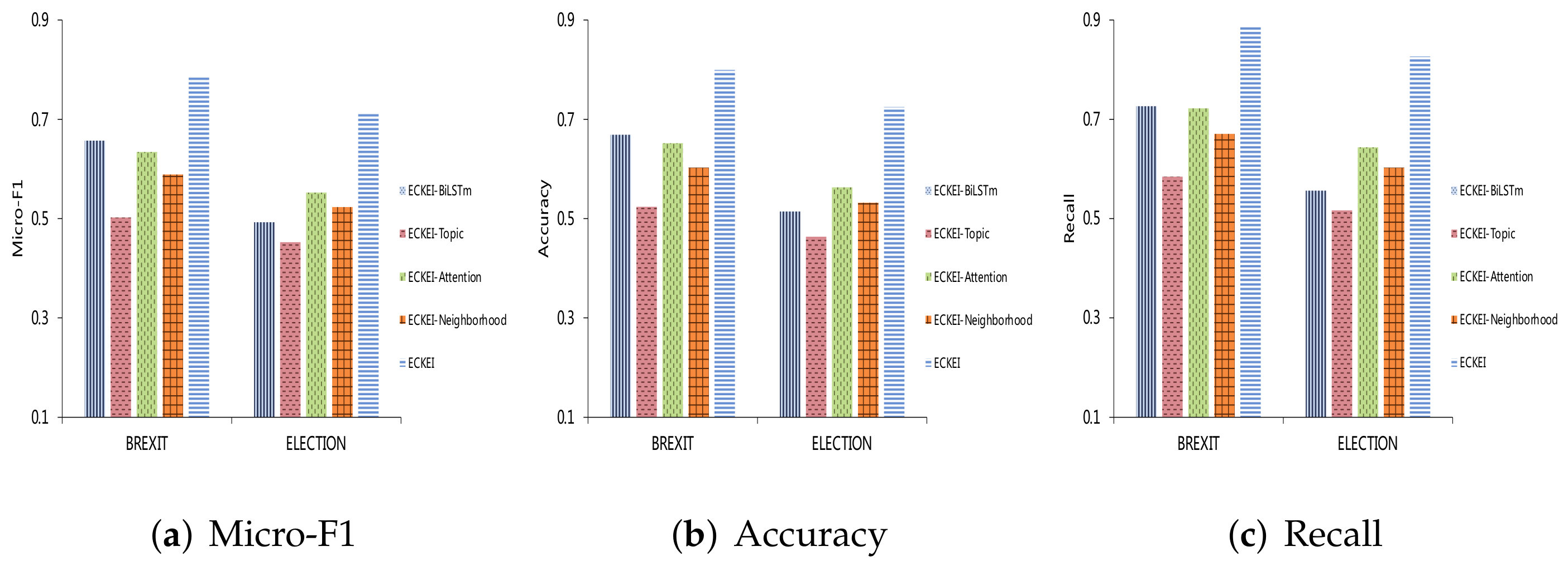
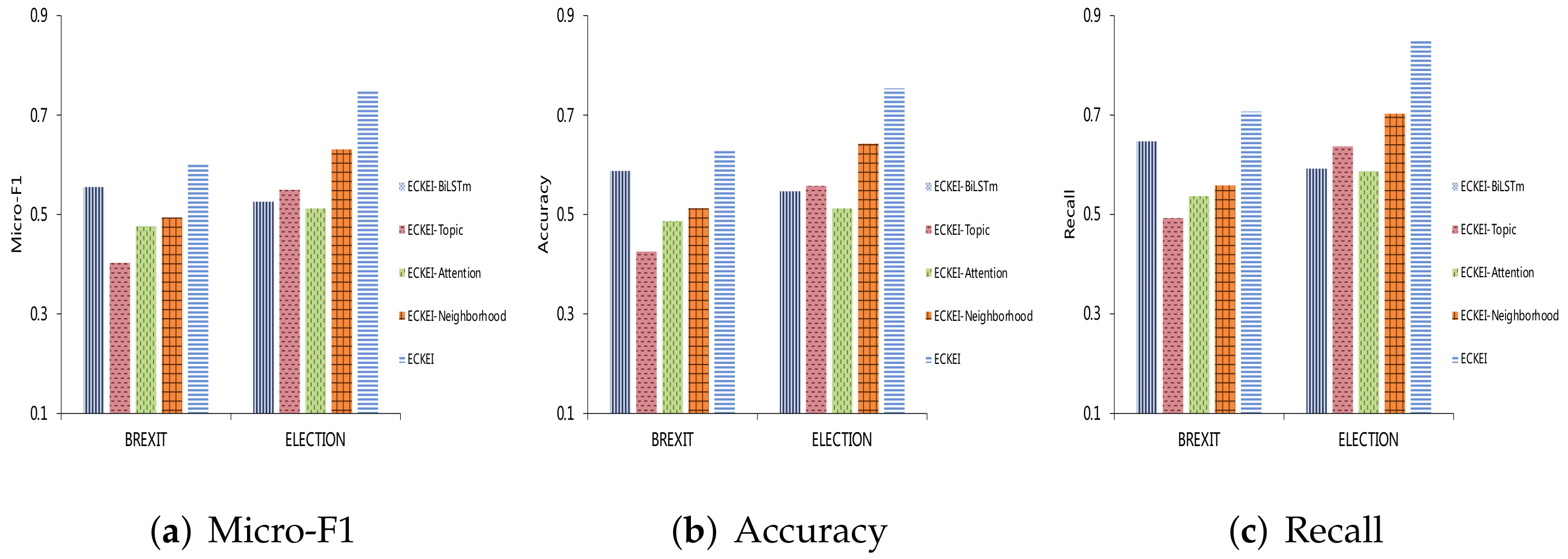
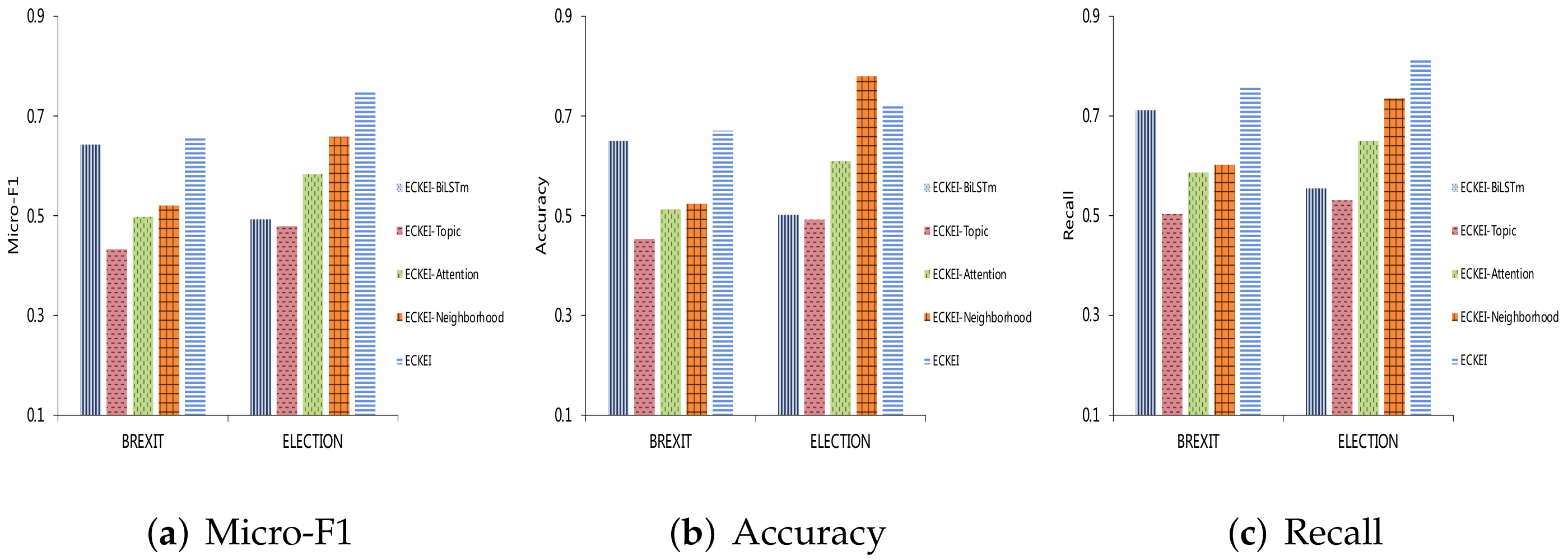
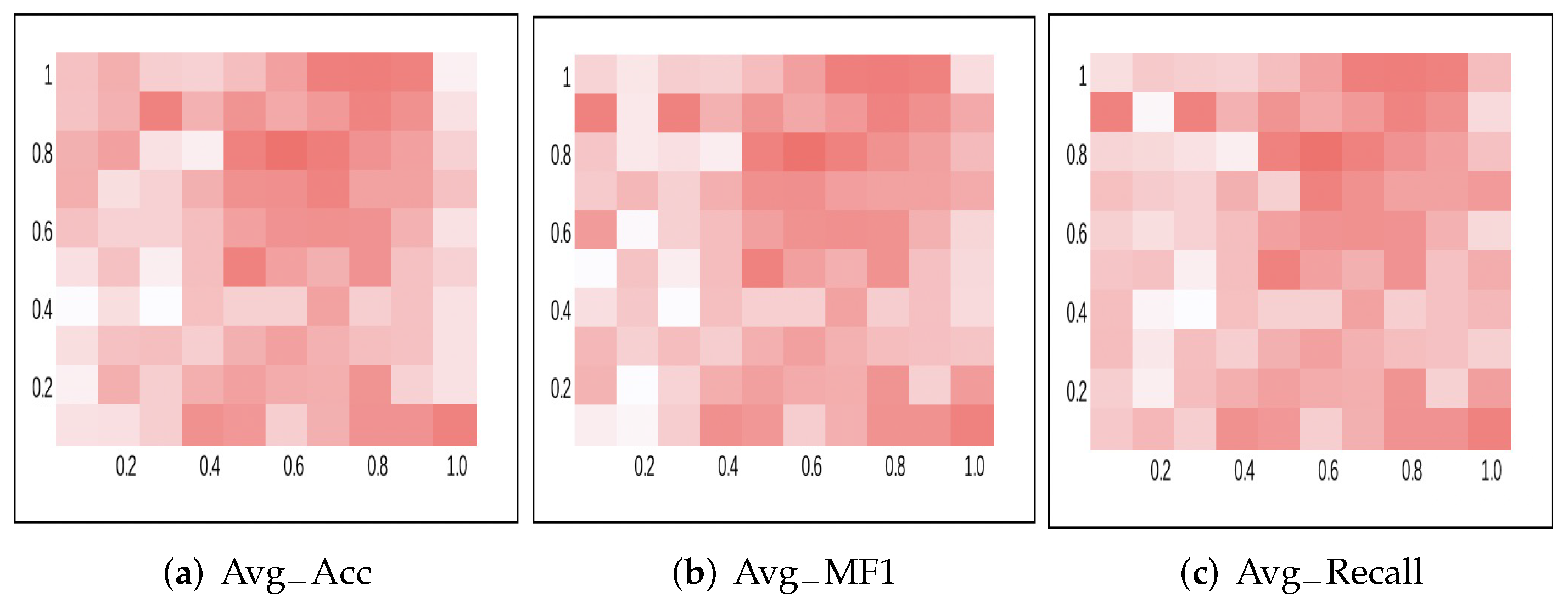

| SenticNet | IsA Event | Part of Celebration | Causes Joy | … |
|---|---|---|---|---|
| wedding | 0.86 | 0.88 | 0.94 | … |
| broom | 0.83 | 0 | 0 | … |
| birthday | 0.85 | 0.98 | 0.97 | … |
| sweep_floor | 0 | 0 | 0 | … |
| User | Tweet | Support | Neutral | Oppose | |
|---|---|---|---|---|---|
| BREXIT | 38,335 | 363,961 | 115,012 | 142,309 | 106,640 |
| ELECTION | 108,689 | 452,128 | 335,479 | 24,215 | 92,234 |
| Dataset | Topic Identification | Topic Words |
|---|---|---|
| BREXIT | Sovereignty | leave work vote mislead stay Europe country control borders independence |
| Economy | EU UK economy jobs Brexit trade free NHS money tax | |
| Immigration | brexit UK EU EURef leaveEU voteleave England migrants refugees Muslim | |
| Campaign | Brexit can’t remain racist attack MP JoCox murder working class | |
| BBCdebate | debate remain BBCdebate voteremain watching blame Boris ITVEURef argument tonight | |
| Boris&Farage | voteleave gove Boris Johnson Farage Brexit Michael Cameron David Geldof | |
| Polls | referendum EU Brexit EURef UK remain alive debate poll polls | |
| Vote | EURef vote referendum Thursday week today debate positive days June | |
| ELECTION | Vote | voting pople day president candidate supporters supporter voted vote America |
| Email scandal | Hillary Clinton emails FBI Comey Comey director Trump talking guy things | |
| Jobs | election world vote state signs jobs tax plan steel China | |
| Slogans | Trump Donald MAGA Clinton president vote election final Hillare IMWITHHER | |
| Campaign | capitol Donald campaign Trump Nugent Ted Clinton sign Reno protester | |
| Election | Donald indirect presideny world Clinton vote united win states campaign |
| Method | BREXIT | ELECTION | ||||
|---|---|---|---|---|---|---|
| AvgMF1 | AvgAcc | AvgRecall | AvgMF1 | AvgAcc | AvgRecall | |
| SVM-ngram | 53.18 | 54.48 | 62.30 | 64.22 | 65.50 | 73.06 |
| NB | 51.76 | 52.59 | 61.18 | 56.28 | 58.80 | 63.54 |
| MITRE(RNN) | 64.35 | 65.81 | 73.14 | 71.64 | 72.96 | 80.62 |
| Pkudblab(CNN) | 61.59 | 62.61 | 69.67 | 66.12 | 67.88 | 75.06 |
| TAAT | 60.44 | 61.78 | 69.48 | 69.45 | 71.08 | 78.45 |
| Aff-Feature | 59.26 | 60.89 | 68.45 | 69.59 | 70.38 | 79.80 |
| ECKEI | 68.65 | 70.05 | 78.48 | 72.86 | 73.44 | 83.27 |
| Method | BREXIT | ELECTION | ||||
|---|---|---|---|---|---|---|
| AvgMF1 | AvgAcc | AvgRecall | AvgMF1 | AvgAcc | AvgRecall | |
| ECKEI-BiLSTM | 62.08 | 63.55 | 69.50 | 50.67 | 52.05 | 56.78 |
| ECKEI-Topic | 45.30 | 46.76 | 52.72 | 49.82 | 50.44 | 56.15 |
| ECKEI-Attention | 54.10 | 55.06 | 61.52 | 55.80 | 56.48 | 62.67 |
| ECKEI-Neighborhood | 53.57 | 54.65 | 61.07 | 64.47 | 65.13 | 68.02 |
| ECKEI | 68.65 | 70.05 | 78.48 | 72.86 | 73.44 | 83.27 |
Publisher’s Note: MDPI stays neutral with regard to jurisdictional claims in published maps and institutional affiliations. |
© 2022 by the authors. Licensee MDPI, Basel, Switzerland. This article is an open access article distributed under the terms and conditions of the Creative Commons Attribution (CC BY) license (https://creativecommons.org/licenses/by/4.0/).
Share and Cite
Jia, P.; Du, Y.; Hu, J.; Li, H.; Li, X.; Chen, X. An Improved BiLSTM Approach for User Stance Detection Based on External Commonsense Knowledge and Environment Information. Appl. Sci. 2022, 12, 10968. https://doi.org/10.3390/app122110968
Jia P, Du Y, Hu J, Li H, Li X, Chen X. An Improved BiLSTM Approach for User Stance Detection Based on External Commonsense Knowledge and Environment Information. Applied Sciences. 2022; 12(21):10968. https://doi.org/10.3390/app122110968
Chicago/Turabian StyleJia, Peng, Yajun Du, Jingrong Hu, Hui Li, Xianyong Li, and Xiaoliang Chen. 2022. "An Improved BiLSTM Approach for User Stance Detection Based on External Commonsense Knowledge and Environment Information" Applied Sciences 12, no. 21: 10968. https://doi.org/10.3390/app122110968
APA StyleJia, P., Du, Y., Hu, J., Li, H., Li, X., & Chen, X. (2022). An Improved BiLSTM Approach for User Stance Detection Based on External Commonsense Knowledge and Environment Information. Applied Sciences, 12(21), 10968. https://doi.org/10.3390/app122110968






